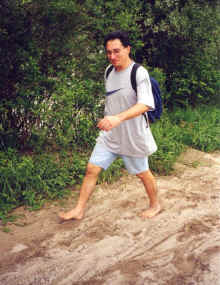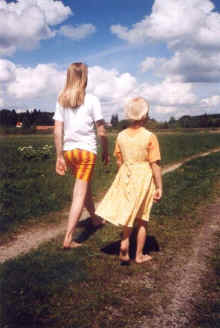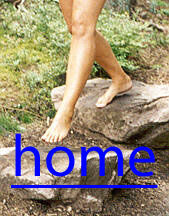Barefoot in Nature
Establish a sensory connection to the earth!
Make use of the sense of touch in
the soles of your feet!
The feeling in the sole is almost as highly developed as that of the palm of
the hand! Just like animals and plants, you will once again share the
sensation of warmth and coldness, the roughness of a dry ground or the
freshness of dewy grass.
On bare feet you relax and improve
your body awareness:
Body awareness training is central to all relaxation techniques. We too
often use our minds and do not feel sensations. Going barefoot in nature is
so simply and easily done, and nor recognized as a relaxation doctrine. But
it equals their benefits in bringing together body and mind! What you feel
with the feet is far from the brain, but close to nature, and is a healthy
counterbalance to overcome internal strains and stress.
Going barefoot protects the
environment:
It preserves plants and the earth, does not make noise -- and without shoes
we develop a vigorous environmental instinct:
- A barefoot person always keeps eye
contact with the ground.
Thus plants and animals can be avoided and will not be not
harmed.
- A natural reluctance to avoid
scrub, thorns and the sharp edges of reed grasses teaches barefooters to
respect sensitive ecology.
- Barefoot hikers want to see what they
step on; therefore they avoid cross-country marches, which might
damage the environment. They prefer to stay on low grass, sand or earth
and seek pleasant ways through fields, forests and meadows.
- On gravel or in swampy areas
barefooters tend to move very carefully, therefore they are no danger for
hidden animals like birds breeding on the ground.
- Worn-out shoes cannot be
recycled. So it is much better to save leather and minimize waste!
- For barefoot walking over longer
distances, natural ground (i.e. lawn, earth or sand) feels much
more pleasant than pavement, asphalt or concrete. With shoes on our feet,
we were dull to the gradual loss of natural ground during emergence of our
urban environment. But our bare soles cannot ignore what happened! Those
who like to go barefoot, should stand up for unsealing the earth and thus
saving one of the most important natural ressources.
The essence is: free to your feet!
The feet can enjoy their freedom very intensely. No doubt, in special
situations the feet need to be protected, but this should not result in
lifelong confinement! Being barefoot should be part of an active lifestyle
and open you new experiences. Be courageous and regain your well-being and
self-confidence!
Going barefoot is so easy:
- You need not become a fakir
who walks on nails and hot coals. Just keep your feet away from
stubble-fields, sharp-edged stones, piercing reed, and as well as from
extremes of temperature! With gradual conditioning, however, the feet can
learn to adapt to various surface and weather conditions. Nevertheless,
beware of trying too much too soon!
- Usually the ground is warmer
than expected,
for it collects solar warmth better than the air. Even on sunny days in
early spring it feels pleasantly warm! On the other hand, the ground can
be quite frosty in the early morning hours after a clear night.
- To start off, short
outings on pleasant ground are just the right activity. Within a few weeks,
the soles become tougher, your rhythm and motion more harmonious and the
sensation becomes wonderful! Soon the soles will have developed sufficient
stability to walk on field and forest paths, and even to resist flat
pieces of broken glass.
- Thickened skin at the
edge of the heels may become too rough. Therefore lotion or lanolin should
be applied regularly to prevent cracked skin.
- If the sun is intense,
the feet may need sunscreen.
- A well conditioned sole is
unlikely to suffer injury, if you avoid stepping on thistles,
reed grasses, thorny plants and flowers attracting bees (like clover).
Broken glass may hide along streets and around sport facilities, barbecue
places or bathing areas. Be more cautious, if your soles are not yet
toughened, and especially if you are allergic to insect stings or if you
have not had a tetanus vaccination!
- When running, the
impact on the soles can be substantial -- therefore the ground should be
free of sharp stones and splinters. Be cautious when jogging in unknown
areas!
- Some strips of adhesive or
bandages should be in your pocket. Usually you will need them to
treat the blisters of your shoed companions!
- If performing heavy labor,
you should wear appropriate shoes. This is advisable for example when
moving heavy loads, caring for horses, lawn-mowing, or hiking in high
mountain areas. But then shoes must be sturdy enough to protect your feet!
- Where poisonous insects, animals,
or plants
are known to exist and may hide from you, barefoot hiking requires
peculiar caution.
- Dirt is easily washed away,
and this takes much less time than healing blisters due to poorly fitted
shoes.
|




|




